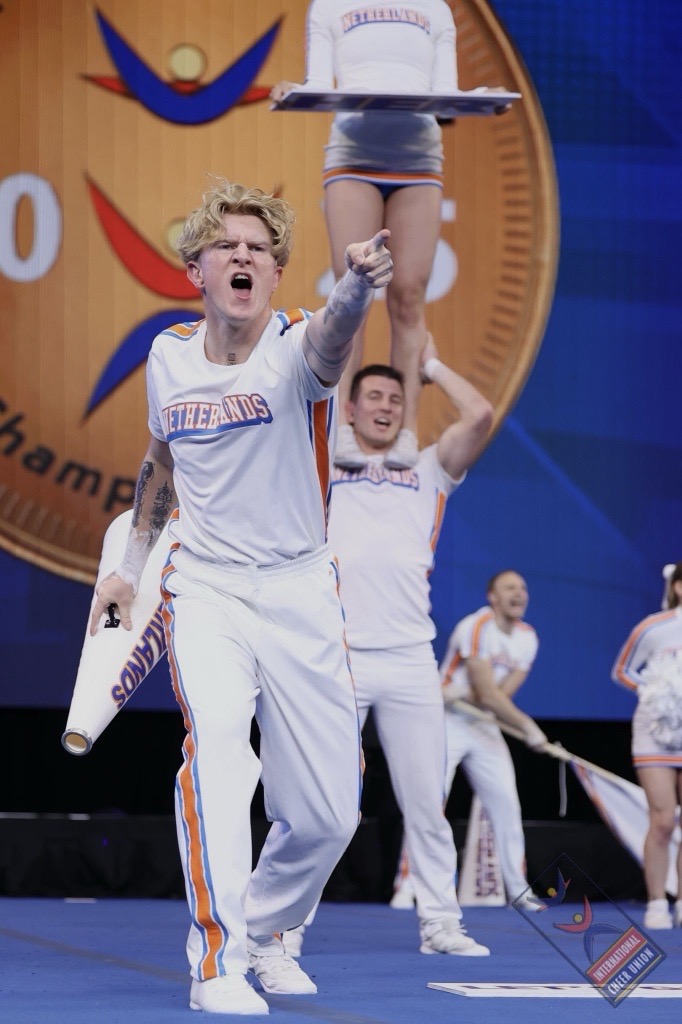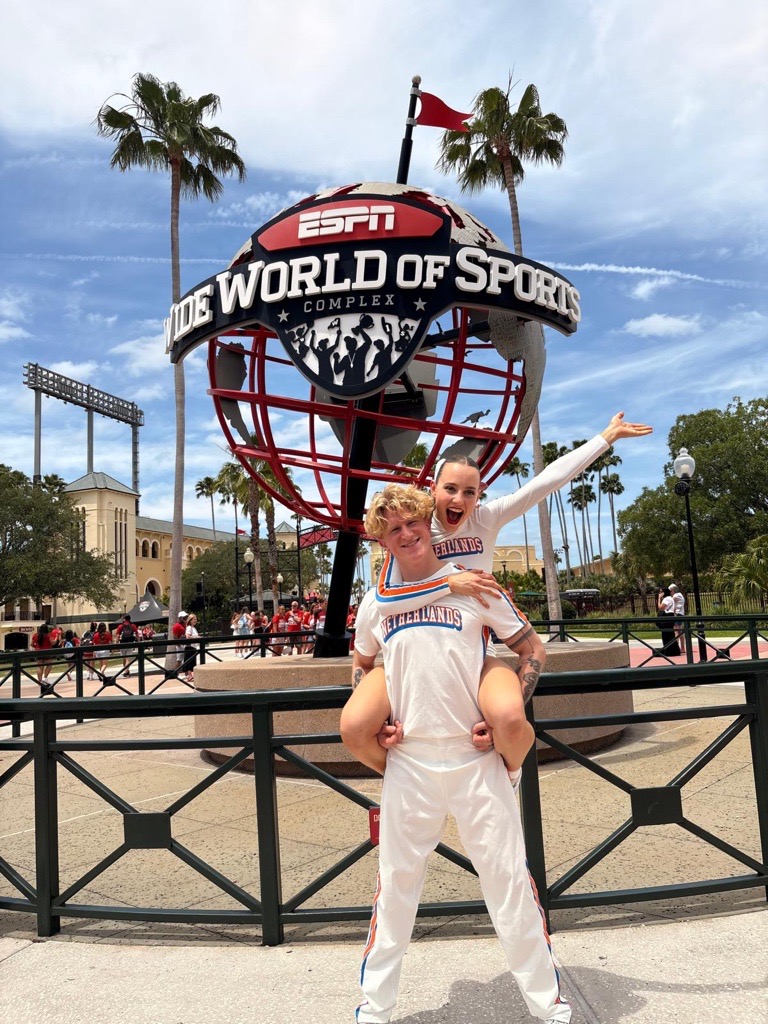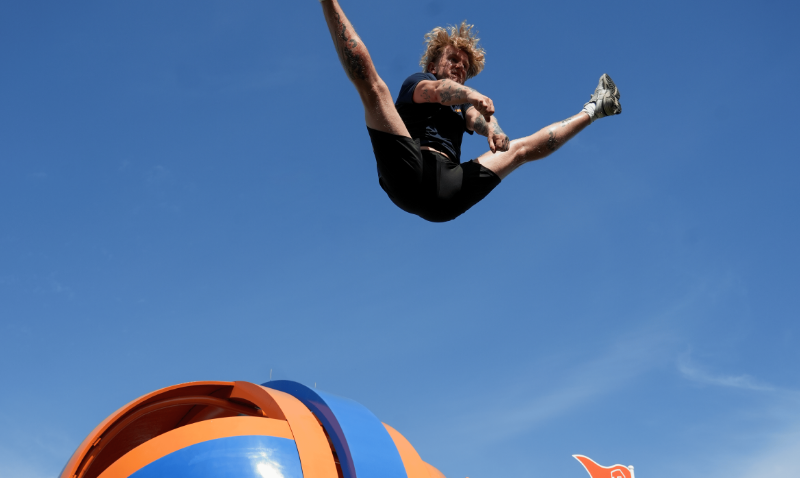Colleagues at Windesheim know Melvin Coolen as ‘applicatiebeheerder’ (software application manager), but outside office hours he is a professional cheerleader. He has just returned from Florida, where he participated in the World Cheerleading Championship with Team NL.
“Very cool, almost unreal or something,” Melvin beams when he looks back on his American adventure; Orlando is the ultimate Valhalla for the cheer world. “The best athletes come together here, which is great fun. But we had to get used to the temperature. In Orlando it is 91,4 °F , weather conditions that we are not used to here in the Netherlands. During the first training days we noticed that stunts that were self-evident in the Netherlands suddenly weren’t possible anymore, or that you were completely exhausted after a routine. That led to a lot of tension and frustration in the team, so just before the competition we really had to reset together; talk things out openly and adjust them. That helped enormously and the moment we walked onto the world floor we peaked at the right moment. We were there.”
Cheerleading in the Netherlands

The Netherlands eventually finished ninth out of eleven participating countries, which is certainly an achievement to be proud of, Melvin emphasizes: “In the Netherlands, cheerleading is a small sport. The association works hard to become NOCNSF recognized so that the sport can be better facilitated. In addition, the athletes who start cheering are often around twenty-five years old and therefore a bit older. That is not bad, but in America children often start cheering at the age of six, which gives them a huge advantage. Here, it is usually athletes who end up in cheerleading after gymnastics, acro or dance and that is why our level remains a bit lower. Cheerleaders in the Netherlands are a group of motivated people who really want to, but you notice that they are all in their first or second year and started just a bit too old in terms of growth.”
Substitute
Melvin sees cheering as “an ideal mix between brute force and putting on a show, technique and team spirit.” Cheerleading actually contains all the elements of sports he has ever practiced, and which he still enjoys very much.
“As a child I did gymnastics at a high sports level. Later I switched to acrogymnastics, dancing and tumbling. During my studies in Groningen I was approached to fill in for a student team for a gymnastics competition, and at that competition I was seen by people from the European Gymnastics team. They said: ‘Hey, we have a competition in Italy soon. You can dance and you are good at tumbling, so do you want to come?’ So I went to the European Championships and slowly rolled back into the higher sport.
A year and a half ago, a cheerleading association approached me via Instagram that they were looking for someone for a competition team. At first I hesitated because I was not really qualified for that, but I tried it anyway and immediately found it super fun. I am not the best or strongest, but I started as a substitute on different teams, and if you do that long enough, you will eventually become good.”
Worries and insecurities
Melvin doesn’t shy away from doing the splits, jumps or somersaults. However, he sees fears and sports-related stress developing in many cheerleaders. He advocates talking about it more openly.
“I myself have a fear of heights, while I like being thrown. For a man I am relatively small and light, so they sometimes throw me. But if I have to stand on someone’s hands with one foot, I find that quite scary. Your whole body stiffens and screams: ‘Get off!’ That is a reflex that you have to learn to turn off and just learn to trust that it will be okay.
You notice that cheerleading is a sport with many physical problems and insecurities: athletes are quickly inclined to think that stunts will not work because they are too heavy.
I have seen a flyer, the person who is thrown during a competition, stop eating a few days before a competition in the hope of losing weight quickly; or on the day of a competition does not dare to drink water. We sometimes have athletes who lift lighter than the people above them. But we state emphatically: someone is never too heavy! We are just practicing or you are working to get your own strength up to par. Working above your head is just very hard and does not always work.
From the association, but also in our team and at clubs, there is now fortunately much more attention for body positivity. You have to find a combination between being strict and kind to your body. Some athletes need you to say in a very sweet way: ‘no, don’t worry, it’s not your fault’. With other athletes you have to be tougher and set boundaries: ‘if I notice that you haven’t eaten, you won’t come into the hall’. Or: ‘if you don’t eat, you won’t get into a stunt’. It’s that simple. It’s an intensive sport. You need muscles, you have to feed yourself well and hydrate yourself.
World stage as learning process

As long as Melvin can remember, he has always done a lot of sports intensively outside of school. “Only during COVID I only did a little fitness for two years, but that made me very unhappy. I started to miss the drive, because I always did competitive sports.” But that competitive feeling did not always turn out to be healthy. At one point Melvin even experienced it as an addiction.
“It’s pretty unhealthy to always need motivation and a goal. You set the bar so high that you indirectly determine your self-worth based on medals. ‘If I get a gold medal, then I’ve done well.’
I also always told the most arrogant story that I have 56 medals of which 54 are gold. And if a competition did not go well, then I would either train twice as many hours, which meant that I ended up doing too much, or I would do nothing at all because I thought: ‘well if I don’t get any medals anyway, then I don’t have to do it anymore.’
It was precisely because of my World Cup adventure that I learned to deal with it better. Of course, you can never say that it wasn’t in the cards, but the expectation was not that we would win prizes with TeamNL in Orlando, because the level of other countries is simply much higher.
Just before we went to America we did our show for family and friends and we got so many positive reactions. Loved ones who told us how cool they thought we were and how proud they were that we could represent the Netherlands. Now I realize that we were our biggest opponent: that changed my mindset because I am no longer concerned with medals or the first place to prove something to someone. I just want to show people that I do what I like and I am incredibly proud of my team.
Now I am 27 and I think I still have about two, maybe three years left as an athlete. As an athlete I want to learn one specific skill and that is the double screw. And then I would find it really cool to be in a team where I can do that at a competition. In Germany there is a high-level team where I think I can have a chance. When my peak is over I would like to become a coach and take cheerleading in the Netherlands to a higher level.
text: Reinhilde van Aalderen
photos: through Melvin Coolen
